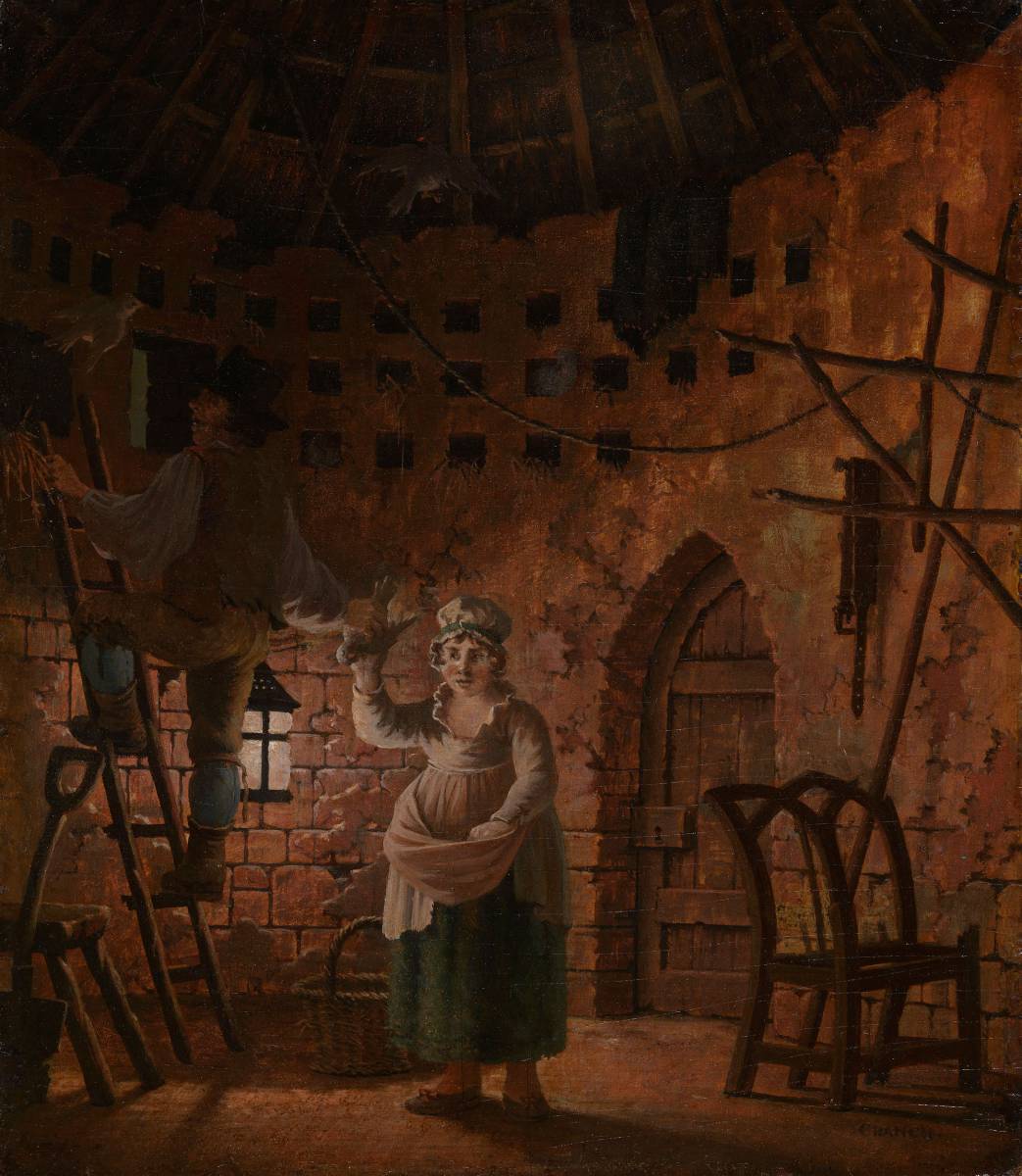This charming interior view of a dovecote is by John Cranch, a little known but fascinating painter who is best remembered for his contact with the young John Constable. The lamp-lit interior shows Cranch’s interest in Dutch painters, such as Teniers and his fascination with the activities of rural life. Cranch’s naturalism and interest in subjects beyond the normal range of academic history painting had an important early impact on the young John Constable, who met him with J.T. Smith at Edmonton in 1796. It was this meeting which convinced the young Constable to pursue a career as a painter and Cranch’s guidance, both practical and theoretical, had a profound influence on Constable’s development as an artist.
Cranch was born at Kingsbridge, Devon, on 12 October 1751. Little is known of his life prior to the exhibition of his first painting at the Society of Artists in 1791, Burning of the Albion Mill, when his address was given as 1 Old Broad Street, London.[1] It seems that Cranch was largely self-taught, although he may have received some instruction from a Catholic priest while a clerk at Axminster. Cranch preferred rural genre themes, exemplified by Monks with a Lantern in a Moonlit Landscape of about 1795 and now in the Louvre, Paris, which recalls the lighting effects of Joseph Wright of Derby.[2] Cranch was a close friend of the engraver, draughtsman and drawing master John Thomas Smith, and the two men played an influential role in the development of the young John Constable.
Constable met Smith and Cranch when engaged on family business outside London – staying with his uncle Thomas Allen, a brewer - the two professional artists offered practical instruction which helped Constable improve his drawing skills, whilst Cranch encouraged his reading. Two of Constable’s earliest experiments in oil painting, The Alchymist and The Chymist, show his stylistic debt to Cranch’s interior scenes; Constable himself described his early landscape, Moonlight Landscape with Hadleigh Church, in a letter to J.T. Smith: ‘I have lately painted a small moonlight in the manner or style of Cranch.’[3] Cranch’s importance to the young Constable is demonstrated by the survival of a remarkable document, a memorandum entitled: ‘Painter’s Reading, and hint or two respecting study.’ This engaging list of publications was prepared by Cranch for the young Constable in September 1796 and includes a survey of literature for the aspiring painter. Cranch notes that Reynolds’s Discourses should be read with caution, as ‘they go’ he explains: ‘to establish an aristocracy in painting: they betray, and I believe have betrayed, many students into a contempt of everything but grandeur and Michael Angelo: the force, and the splendid eloquence, with which the precepts are inculcated, makes us forget, that the truth of Teniers, and the wit and moral purpose of Hogarth, have been, and will for ever be at least as useful, and diffuse at least much pleasure, as the mere sublimities of Julio and Raphael.’[4]
For Cranch Reynolds’s hierarchy of painting was too restrictive, so he advised the young Constable to study: ‘the general habitudes of men and things; or Nature, as she is more and less perverted by the social institutions.’ This cry for naturalism was one that Constable would echo throughout his career and seek to emulate.
Cranch exhibited only nine paintings during his lifetime, seven of which were shown at the 1808 British Institution exhibition. Cranch also published two treatises: On the Economy of Testaments in 1794, and Inducements to promote the fine arts of Great Britain by exciting native genius to independent effort and original design in 1811. This rare panel of two figures in a Dovecote perfectly illustrates his style and the aspects of his painting which most appealed to the young Constable.
References
- For Cranch’s works see ed. Hugh Belsey, From Gainsborough to Constable; the emergence of naturalism in British Landscape Painting 1750-1810, exh. cat. Sudbury (Gainsborough’s House), 1991, pp.58-62.
- Eds. Élisabeth Foucart-Walter, Olivier Meslay and Dominique Thiébaut, Catalogue des peintures britanniques, espagnoles, germaniques, scandinaves et diverses du musée du Louvre, Paris, 2013, cat. no.R.F.1991-17, p.22.
- Graham Reynolds, The Early Paintings and Drawings of John Constable, New Haven and London, 1996, cat. no. 96.I p.7.
- eds. Leslie Parish, Conal Shields and Ian Fleming-Williams, John Constable: Further Documents & Correspondence, London, 1975, pp.199-201.

